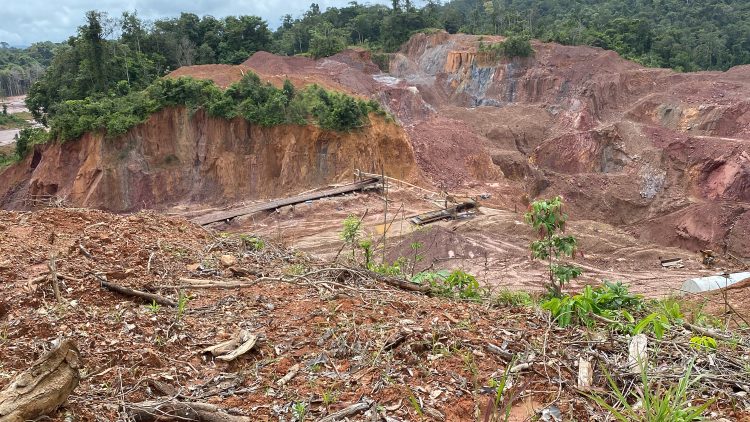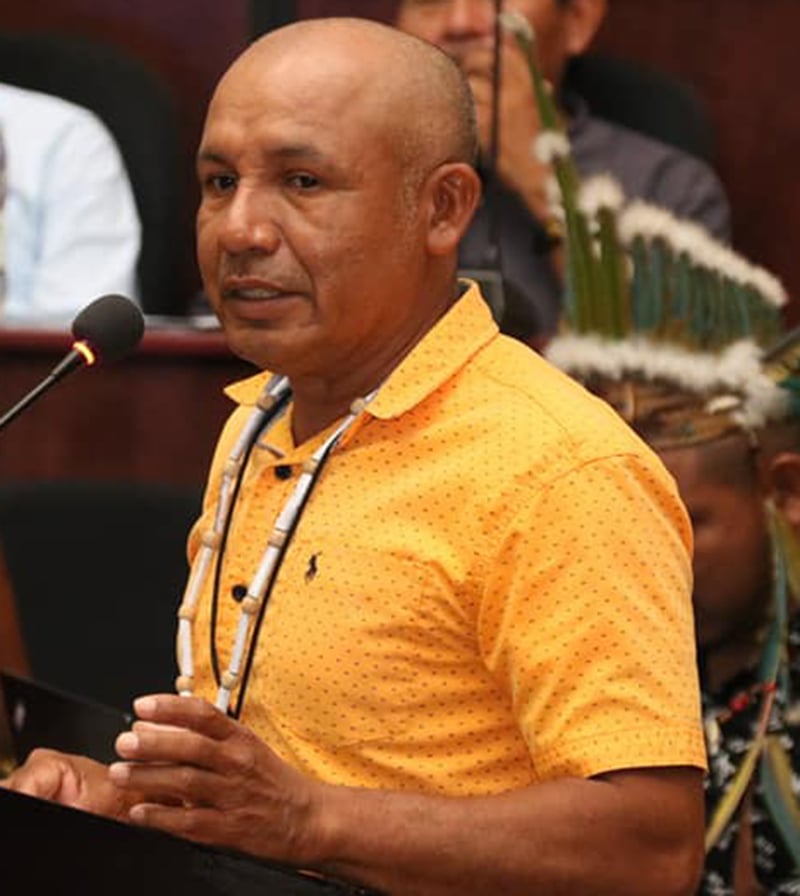Just over two weeks after he told Stabroek News that the rights violations in Chinese Landing and Isseneru had been identified as an “immediate priority” for the newly formed National Toshaos Council, Chair Derrick John has now made an about-turn stating that the communities must now write the Council requesting its intervention.
“…send us a letter requesting our intervention because even though that we recognize or we know [what the situation is] officially we would like to have some form of correspondence that outlines that this is the situation officially,” John told Stabroek New during a brief interview yesterday.
Both Chinese Landing, Region One and Isseneru, Region Seven have taken the government before international commissions seeking relief for the plethora of rights violations they say they have experienced and continue to experience.

Shortly after taking office in July, John – the toshao of Moraikobai in Region Five – told Stabroek News that President Irfaan Ali had indicated that a team was sent to the Chinese Landing community to meet with the miners and villagers in order to assess the situation, adding that the NTC will be fielding a team to visit the Region One community.
“The core executive is new at the leadership of the NTC but we have so far identified that the issues at Isseneru and Chinese Landing (are) urgent and our priority. As you know those issues are before the courts but they were raised and we discussed it. I also raised it with the President as well but we got to respect the court and allow the court process to go forward.
“…We will discuss it at the NTC level. One of the first things that we would like to do is to go down on the ground to assess it for ourselves and reach out to the communities and to have a first-hand experience (of) what’s happening and only then we would be in a better position to do whatever we can do to try to bring some comfort to the communities. Most of us from the NTC executive core, we are new to this…we want to go to Isseneru. We want to reach the community and then put us in a better position because these are very serious cases and we have to get facts. Our approach is to go there and see exactly for ourselves so that we can all set up a plan how and what the next step is,” he had said.
John also said that the NTC Executive was aiming for a visit to those communities before the end of August 2022.
Yesterday, when asked by Stabroek News for an update on the planned visit, John said that it is on hold for now because the NTC is preparing for Amerindian Heritage Month celebrations.
“Presently I’m making plans to go up there and hopefully it’ll be done before the end of the year because you know Heritage Month is just on and we had this observance of World Indigenous Day so a lot of preparation had to be done for these two occasions, but not denying that there’s not a problem.
“We recognize, we are aware of it and surely we are very concerned also about the situation and definitely Chinese Landing need to be given some focus. Right, so very soon we will be making special effort to go there so that we can … see exactly the situation of what is happening there,” he said.
Last week, Stabroek News travelled to the remote indigenous village where it was related that approximately 500 miners are occupying the mining blocks within the community, threatening both the health and livelihood of the community members.
Incursion
The incursion by miners into the indigenous village has been continually raised with various government ministers and successive NTC Executive bodies but the community has not seen any real relief. Its leaders say miners not only threaten the livelihood of the villagers but also blatantly breach the Amerindian Act with help from members of the Guyana Police Force.
Chinese Landing, a Carib indigenous community, is a remote village along the Barama River in the Barima-Waini region and it received its land title in 1976 under then Prime Minister Forbes Burnham. The village received its Certificate of Title on August 10, 2018, for 30.06 square miles or 19,241 acres of land.
The miners currently occupy a section of the village called Tassawini – the gold-rich area. That area has been allocated to Wayne Vieira, a businessman from Houston, East Bank Demerara, to mine back in 1995. The village has said that it was done without their free, prior and informed consent.
The mining blocks fall in the centre of the community’s titled lands and have been its main source of income. However, since its allocation to Vieira, the community has been engaged in a battle with him to regain control. Guyana’s apex court, the Caribbean Court of Justice, has already ruled that Vieira cannot be prevented from mining in the area since he legally owns the blocks there. Just last year, the High Court also dismissed a challenge brought by the community against Vieira. That judgment is currently being appealed.
The village’s toshao Orin Fernandes led a team to Georgetown for the National Toshaos Conference last month where they met with the President, Vice President and Minister of Natural Resources. Promises were made to send a high-level team to the area but that has not been done as yet.
Asked what representation is being made on behalf of the village to the government, John said that they have not really discussed the issue. He went on to explain that the government indicated to him that a team went in but when Stabroek News informed him that the residents are saying that no such team was sent in, John seemed flabbergasted.
He then said that the NTC would now have to engage the government to “have another conversation with them about how we can able to work to address this issue.”
Further questioned as to whether he had reached out to toshao Fernandes, John said that he has not.
“No, well that’s something that we have [not done]. I actually missed taking his contact information [at the National Toshaos Conference] but we are hoping that probably if he can make contact with us or even send us a letter [we would be able to establish contact],” the NTC Chair explained.
“As I said, we’re very concerned because this is affecting the lives of our brothers and sisters. So we sympathize with them and we hope that we can able to bring an early solution to the problem,” he added.
After the dismissal of their case, the Chinese Landing Village Council approached the United Nations Committee on the Elimination of Racial Discrimination (UN CERD) and complained about a number of violations under the Amerindian Act. The Council had submitted that these violations are being perpetuated by both the government and miners, who were granted permission to operate on titled, customary and sacred lands within their communities.
Contending that the government granted a medium-scale mining concession to Vieira in its titled lands without consulting or seeking the consent of the community, Chinese Landing had informed CERD that there has been an increase in unwanted mining which poses a risk to its traditional way of life and its environment. It further alleged that a High Court dismissal, without a hearing, of a claim filed by the community against the Guyana Geology and Mines Commission (GGMC) and Vieira concerning the mining concession has also resulted in an upsurge of a series of incidents of intimidation and assaults on residents of the community, by miners and members of the Guyanese Police Force.
CERD, in identifying areas for the government to take measures on, has since proposed consideration be given to suspending or revoking the mining concessions that affect the lands, territories or resources of the Chinese Landing and the Wapichan indigenous peoples until free, prior and informed consent is granted by the indigenous peoples; refraining from approving projects and granting mining permits or concessions within the lands of indigenous peoples, whether titled or not; ensuring that Indigenous Peoples have access to effective and prompt judicial and other remedies to seek protection for their rights; prevent and investigate incidents of threats and violence against residents of the Chinese Landing indigenous community by miners and by members of the Guyanese Police Force; incorporating the principle of FPIC in domestic legislation, including by amending the Amerindian Act of 2006, with indigenous peoples’ participation, and to fully and adequately guarantee the right to consultation of indigenous peoples; and considering ratifying ILO Indigenous and Tribal Peoples Convention (No. 169).
The government, given until July 15 to respond to the CERD, has since submitted its response to the UN but the details are yet to be made public.
For now, the people of Chinese Landing continue to be denied the opportunity to earn from their village resources. They are restricted from visiting the mines and operators there refuse to employ villagers or even support community businesses. Apart from mining, there are not many more earning opportunities within the community.



